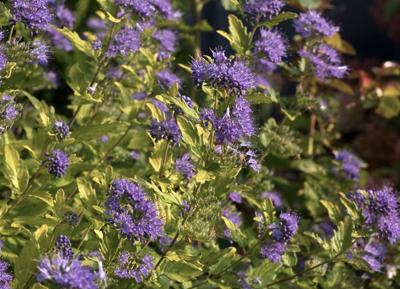The Garden Guy had the opportunity to add three Sunshine Blue II Caryopteris to the garden in late summer and I am glad I did. I’ve been a fan of Caryopteris for a long time but haven’t had a chance to grow it since I was a horticulturist with Mississippi State University.
Sunshine Blue II is a relatively new selection of Caryopteris incana and was hybridized by famed plantsmen, aka The Plant Hunter, Tim Wood. It is recommended for zones 5-9, which is a huge geographic area in the United States. So this tells you it is tough for cold extremes and by its drought tolerant nature, will persevere in torrid summers like the one we have just lived through. Your job will be to just make sure it is not in boggy winter soil.
Sunshine Blue II will get about 3 feet tall and wide. When I first started growing it, I was taught it was in the verbena family, and now it is happy in the mint family, until some taxonomist with clout gets unhappy. I’m just kidding. Fear not of the mint family relationship, this is a well-behaved shrub-like plant.
Caryopteris incana has common names like bluebeard, blue mist spirea. To me, blue mist is really the perfect description. The flowers are mist-looking, small bottle brush-like and when you look at it through a telephoto lens or a pair of binoculars you mutter a "holy wow" as you realize you are seeing one of nature's most exotic looking blooms. Oddly the timing of the blooms is similar to other great blue mist flowers like the hardy ageratum a native Conoclinium, and the Crucita, the pollinator champ in South Texas known botanically as Chromaelena odorata.
A camera and a pair of binoculars with close-up capabilities really come in handy for all three including Sunshine Blue II. It will be one of your Serengeti-type plants, bringing in a host of bees and butterflies and of course the creatures that want to eat them. Pull up a chair and get ready for the time of your life.
Here I am touting the wild or habitat aspect of the plant but its beauty is certainly a reason you will want it. Mr. Wood, how did you ever get such beautiful chartreuse gold foliage coupled with late summer and fall blue flowers in timing at the peak of pollinator season?
One of the reasons I jumped on my opportunity to get these plants, besides beauty and their affinity for pollinators, is that they are not on the deer menu. This year the deer must have been really hungry as they ravaged the flower under the dining room window and even ventured up the steps to the front door to eat plants out of my self-watering AquaPots. This was also in spite of me using the four leading deer repellent products.
The 3-foot-by-3-foot shrub-like stature gives great combination possibilities. I have visions of modifying one of my other deer ravaged beds and planting in partnerships with Meant to Bee Royale Raspberry and Queen Nectarine agastache, as well as Truffula Pink gomphrena. The result should be my own personal pollinator festival.
Sunshine Blue II maintenance is easy,;no deadheading and simply chill until you see signs of growth emerging in the spring. This will be your time to cut back hard. If you will be planting yours in late spring or early summer plan on spacing 24 to 36 inches apart.
Of course, in the competitive world of the garden center business, finding your plants may be a challenge. So, start sourcing and asking that magical question: Will you get some for me?








